Welcome to our guide on subwoofer box design! If you're a car audio enthusiast or someone looking to upgrade their audio system, understanding the proper design of a subwoofer box is crucial. A well-designed subwoofer box enhances the bass response and improves the overall sound quality of your audio system.
This blog will discuss the basics of subwoofer box design, different types of subwoofer boxes, the importance of correct box sizing, tips for building your subwoofer box, and much more. So, let's dive in and explore the essential tips for subwoofer box design!
Understanding Subwoofer Box Design
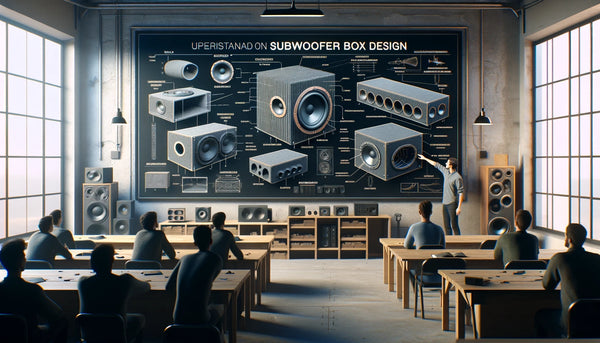
Regarding subwoofer box design, it's essential to understand the basic principles. A subwoofer enclosure, also known as a box, is critical in delivering your subwoofer's best possible bass response. The box design influences the subwoofer's performance and sound quality. Properly designing the enclosure can optimize the air volume inside the box, control the bass response, and prevent unwanted distortion caused by over-excursion. So, let's delve deeper into the world of subwoofer box design and learn how to create the perfect enclosure design for your subwoofer.
Different Types of Subwoofer Boxes
Regarding subwoofer box design, there are several different types to consider. Each type has its unique characteristics and advantages.
-
Ported boxes, also known as vented enclosures, use a port or vent to enhance bass response. These boxes allow air to move in and out of the box, resulting in louder, deeper bass. Ported boxes are known for their high power handling and increased bass output, making them ideal for those seeking a super bass speaker box design for bass.
- Bandpass boxes are designed to maximize bass efficiency. They consist of two chambers, one sealed and one ported, which work together to produce maximum bass output. Bandpass boxes are known for their high SPL (sound pressure level) and superior bass response, making them ideal for car audio competitions or anyone looking for a speaker box design for bass.
- Sealed enclosures, or acoustic suspension boxes, provide precise and accurate bass reproduction. These airtight boxes allow the subwoofer to achieve a tight, controlled bass response. Sealed enclosures are known for their clean, accurate sound quality, making them popular for music enthusiasts who prioritize accuracy over sheer volume.
Importance of Correct Box Sizing
The size of the subwoofer box plays a crucial role in achieving optimal bass response and overall sound quality. A box that is too small can result in limited bass output, while a box that is too big may lead to excessive distortion and poor frequency response. It's essential to select the correct size box based on the specifications of your subwoofer and the available space in your vehicle. Achieving the correct box size is essential for maximizing bass response, ensuring the subwoofer operates efficiently, and delivering the desired audio experience.
If you're wondering how to build a subwoofer box for deep bass, ensuring the correct size and design of your box is the first step. A well-designed box tailored to your subwoofer's specifications and your listening preferences can dramatically enhance your audio system's bass performance.
Impact of Size on Sound Quality
The size of the subwoofer box not only affects the bass response but also the overall sound quality. When the box is sized correctly, the subwoofer can operate within its optimal frequency response range, resulting in clear, defined bass. A smaller box typically produces tighter, more controlled bass, while a larger box size can yield more profound, extended bass.
However, striking the right balance is essential, as a vast box can lead to boomy, less precise bass. Additionally, the box size can impact the upper-frequency response, specifically the upper frequency response, especially if the box is not sealed correctly. Therefore, selecting the appropriate size box is crucial for achieving the desired sound quality and ensuring a well-rounded audio experience.
Box Sizes for High-Efficiency Subwoofers
High-efficiency subwoofers require specific box sizes to maximize their performance. These subwoofers are designed to handle high power, and the box size is crucial in allowing them to operate at their full potential. The box volume for high-efficiency subwoofers should be carefully calculated, considering factors such as the displacement volume of the woofers and the amount of space available in the vehicle. It's essential to design the box to maximize efficiency, ensuring that the subwoofers can deliver powerful, distortion-free bass. By selecting the correct box size, high-efficiency subwoofers can achieve maximum power handling capabilities while maintaining optimal sound quality.
Calculating Box Sizes for Optimal Performance
To achieve optimal performance from your subwoofer setup, it's crucial to calculate the box sizes accurately. One key factor in box size calculation is the tuning frequency, which determines the frequency at which the box resonates, enhancing the bass response.
Another important consideration is the air volume inside the box, which directly impacts the subwoofer's low-frequency performance. Additionally, the woofer's displacement volume must be considered to ensure that the box size matches the subwoofer's specifications. Calculating the correct box size and geometry ensures that your subwoofer setup delivers the desired sound quality and bass response.
Introduction to Box Size Calculation
Calculating box sizes for subwoofer enclosures can seem complex, but with the help of online calculators, it becomes much more manageable. These calculators consider parameters such as the tuning frequency, volume of air, and displacement volume, allowing you to determine the ideal box size for your subwoofer. By inputting the specifications of your subwoofer, the calculator generates the recommended box dimensions, taking the guesswork out of the equation. This makes the sub-box size calculation process more precise and efficient, ensuring that your subwoofer operates optimally within the designed enclosure.
Calculating Box Sizes for Maximum Performance
Calculating the box sizes for high-efficiency subwoofers involves a step-by-step process to ensure optimal performance. Here are the key steps to follow:
- Determine the required net volume of the subwoofer enclosure, measured in cubic feet, based on the specifications of your high-efficiency subwoofer.
- Consider the port area and length, as these parameters play a significant role in tuning the enclosure and optimizing bass response.
- Use online calculators or software specifically designed for subwoofer box design to calculate the ideal box dimensions, taking into account the subwoofer's parameters, port area, and port length.
- Ensure the box size aligns with the space available in your vehicle, making the necessary adjustments.
- Construct the subwoofer box with the calculated dimensions, ensuring it is well-built, airtight, and braced to minimize vibrations and enhance performance.
What is the importance of subwoofer box design?
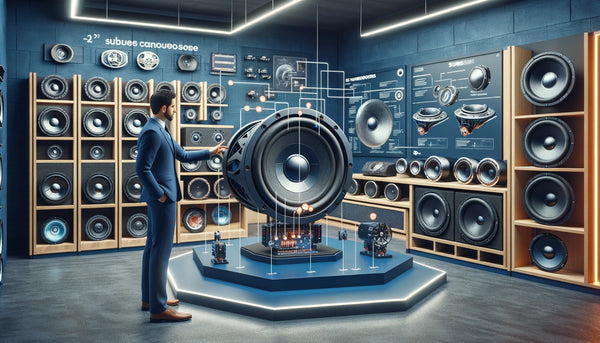
The importance of subwoofer box design cannot be overstated. A well-designed box is crucial because it directly impacts the sound quality, bass response, and overall performance of the subwoofer. By optimizing the air space, minimizing vibrations and resonance, and enhancing bass response, a properly designed subwoofer box can significantly improve the audio experience. Additionally, a well-constructed box helps protect the subwoofer from physical damage and extends its lifespan.
Deciding on Box Type Based on Measurement

When deciding on the type of subwoofer box, it's essential to consider the available space in your vehicle. If space is limited, a compact box design might be the best option, providing impressive bass response without taking up too much room. For those with more space available, a full-size box can offer deeper, more powerful bass by allowing for a larger air volume within the enclosure. The decision between a compact or full-size box will depend on your vehicle's space constraints and your personal preferences for bass quality and volume.
Compact Size Box Plans
Compact-size subwoofer boxes are perfect for vehicles with limited space. These boxes are designed to fit small areas while delivering impressive bass response. They offer space-saving benefits, allowing you to install the subwoofer in various locations within the vehicle. Despite their smaller size, well-designed compact subwoofer boxes can still produce tight, punchy bass, making them a popular choice for car audio enthusiasts who want to enhance their audio system without sacrificing space.
Full-Size Box Plans
For those with ample space in their vehicles, full-size subwoofer boxes are the way to go. These larger enclosures can accommodate bigger subwoofers or multiple units, providing a more substantial bass presence. The increased volume of a full-size box allows for more air movement, which can translate to deeper and more resonant bass tones. Building a full-size box involves ensuring that it's correctly tuned and constructed to prevent any loss of sound quality or efficiency.
Role of Ported Design in Subwoofer Boxes
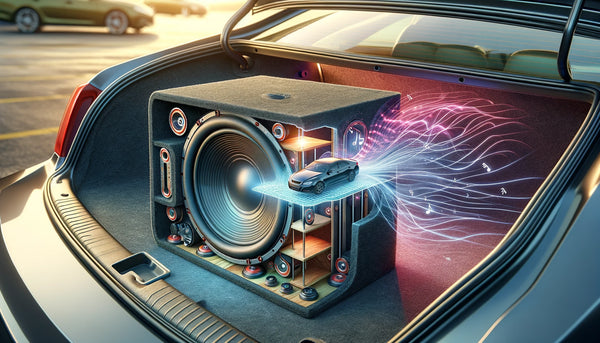
The design of the subwoofer box, specifically the use of a ported design, can significantly impact the performance and sound quality of your subwoofer setup. A ported box, also known as a vented enclosure, features a port or opening that allows air to move in and out of the box. The port area and length are critical parameters in ported box design, as they determine the enclosure's tuning frequency and bass output. Properly designing the ported box with the correct port diameter can enhance bass response, improve frequency response, and higher overall efficiency.
What is a Ported Box?
A ported box is a type of subwoofer enclosure that includes a port or vent, designed to improve the efficiency and bass response of the subwoofer. The port allows the back wave generated by the subwoofer cone to contribute to the overall sound output, resulting in louder and deeper bass. Ported boxes are particularly effective for genres of music that benefit from enhanced bass, such as hip-hop, electronic, and dance music. Properly tuning the port is essential to maximize performance and avoid issues like port noise or turbulence.
Benefits of Ported Box Design
Ported box designs offer several benefits over sealed enclosures, including:
- Enhanced bass response: The inclusion of a port allows for increased bass output, making ported boxes ideal for listeners who prefer a more pronounced bass presence in their music.
- Improved efficiency: Ported boxes can be more efficient than sealed enclosures, requiring less power from the amplifier to produce the same level of bass output.
- Tuning flexibility: The size and length of the port can be adjusted to tune the box to a specific frequency, allowing for customization of the bass response to suit individual preferences or the acoustics of the vehicle.
- Versatility: Ported boxes can be designed to work well with a wide range of music styles, making them a versatile choice for many listeners.
In conclusion, the design of the subwoofer box is a critical factor in achieving the best possible performance from your subwoofer. Whether you choose a compact, full-size, or ported box design, carefully considering the box's size, tuning, and construction can lead to a significantly improved audio experience. By optimizing the subwoofer box design, you can enjoy deeper, more impactful bass that enhances your music listening experience.
Tips for Building Your Subwoofer Box
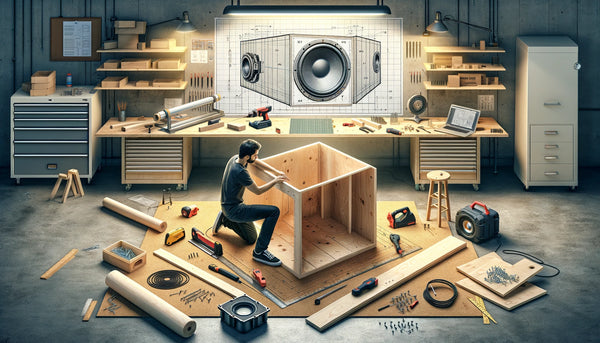
Building your subwoofer box is a fulfilling project that can be tailored to your specific needs and preferences. Here are some valuable tips to ensure success:
- Thorough Planning: Begin with detailed planning, considering your subwoofer's specifications, your vehicle's available space, and your audio goals. This step is crucial for determining the type and size of the box that will work best for you.
- Material Selection: Choose high-quality materials for your subwoofer box construction. Medium-Density Fiberboard (MDF) is a popular choice due to its acoustic properties and durability. Plywood can also be used, especially for boxes that might be exposed to moisture.
- Precision in Construction: Accuracy is key when cutting and assembling the box panels. Use proper tools and take your time to ensure that all parts fit together tightly and securely.
- Airtight Sealing: Ensure the box is airtight to prevent air leaks, which can significantly affect sound quality. Use a good-quality wood glue for assembly and seal all internal seams with silicone caulk.
- Proper Bracing: Internal bracing helps to reduce panel vibrations, which can color the sound and reduce clarity. Bracing is particularly important for larger boxes.
- Testing and Adjustment: Once your box is built, test it with your subwoofer to evaluate performance. Be prepared to make adjustments, such as adding more bracing or adjusting the port size, to fine-tune the sound.
Materials Required for Building a Subwoofer Box
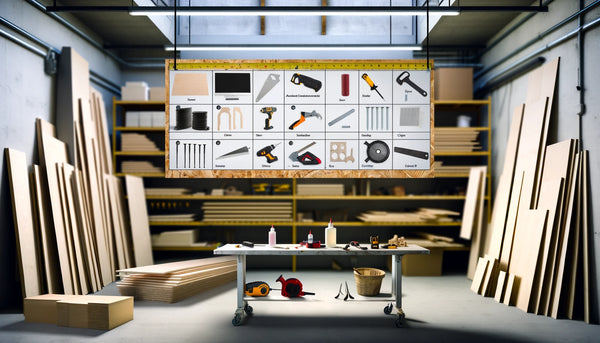
To build a subwoofer box, you'll need the following materials:
- Medium-Density Fiberboard (MDF): Preferred for its acoustic properties and strength.
- Wood Glue: Essential for assembling the box panels securely.
- Screws: For reinforcing the box's structure.
- Silicone Caulk: To ensure the box is airtight by sealing all joints and seams.
- Internal Bracing Material: Additional MDF strips or dowels can be used for bracing inside the box.
- Carpet or Vinyl: Optional, for finishing the box's exterior for aesthetic purposes and protection.
- Terminal Cup or Binding Posts: For connecting the subwoofer to your amplifier.
Step-by-Step Guide to Build a Subwoofer Box
- Design Your Box: Based on your subwoofer's specifications and your listening preferences, decide on the box type (sealed, ported, or bandpass) and calculate the dimensions.
- Cut the MDF Panels: Measure and cut the MDF panels according to your design. Precision is key for a snug fit and airtight seal.
- Assemble the Box: Use wood glue to attach the panels together, reinforcing the joints with screws. Ensure the box is square and the joints are tight.
- Install Bracing: Add internal bracing to reduce panel vibrations, which can improve sound quality.
- Seal the Box: Apply silicone caulk to all internal seams to make the box airtight.
- Install the Subwoofer: Cut an opening for the subwoofer and mount it securely in the box. Make sure the fit is tight and sealed.
- Connect the Terminals: Install a terminal cup or binding posts and connect the internal wiring to the subwoofer terminals.
- Test and Adjust: Test the subwoofer box in your audio system and make any necessary adjustments for optimal sound quality.
Enhancing Subwoofer Performance with Box Design

The design of your subwoofer box significantly impacts its performance. Key design aspects such as the type of box, the precision of its construction, and the quality of materials used can all influence how well your subwoofer reproduces low frequencies.
- Box Type: Choosing between sealed, ported, or bandpass boxes will affect the sound's character. Sealed boxes offer tighter, more accurate bass, while ported and bandpass designs can provide more volume and efficiency.
- Construction Quality: A well-built box, free from air leaks and internal resonances, will ensure that your subwoofer performs to its potential. Pay close attention to the quality of joints and seals.
- Material Choice: The density and rigidity of the materials used can affect the box's sound. MDF is a popular choice for its excellent balance of cost, ease of use, and acoustic properties.
By carefully considering these factors when designing and building your subwoofer box, you can greatly enhance the performance and enjoyment of your audio system. Whether you're aiming for the deepest possible bass for movie watching or tight, musical bass for enjoying your favorite tracks, the right subwoofer box design can make all the difference.
How Box Design Affects Sound Quality?
The design of your subwoofer box plays a pivotal role in shaping the sound quality of your audio system. Here's how different design elements influence the overall performance:
- Volume and Size: The internal volume of the subwoofer box affects the bass response. Too small a volume can restrict the movement of the subwoofer's cone, leading to a tighter but weaker bass. Conversely, a larger volume can extend the bass response but may result in a less controlled sound.
- Ported vs. Sealed: Sealed boxes are known for their tight and accurate bass reproduction, ideal for critical listening and a wide range of music genres. Ported boxes, however, can produce louder and deeper bass, which might be preferable for genres like hip-hop, electronic, or for home theater use.
- Materials: The density and rigidity of the materials used in the construction of the box (like MDF or plywood) can dampen unwanted resonances and vibrations, leading to a cleaner sound. The choice of material can also affect the box's durability and longevity.
- Construction Quality: A well-constructed, airtight box prevents sound from leaking out of unintended gaps, ensuring that all the audio is directed through the subwoofer cone (and the port, in ported designs). This can significantly impact sound clarity and fidelity.
- Internal Bracing: Proper bracing within the box can minimize vibrations of the box walls, reducing coloration of the sound and leading to a purer bass tone.
Common Mistakes to Avoid in Subwoofer Box Design

To maximize the performance of your subwoofer box, be mindful of these common design and construction pitfalls:
- Incorrect Box Volume: Miscalculating the necessary volume for your specific subwoofer can lead to suboptimal bass response. Always follow the manufacturer's recommendations or use a reliable box calculator.
- Poor Sealing: An airtight seal is crucial for the integrity of the sound. Any leaks can result in a loss of bass pressure and a muddy sound.
- Inadequate Bracing: Large panels without sufficient bracing can resonate with the subwoofer's output, introducing distortion and coloration into the bass.
- Over/Under Porting in Ported Designs: The size and length of the port in a ported box need to be carefully calculated based on the box volume and desired tuning frequency. Incorrect port dimensions can lead to port noise and an inaccurate bass response.
- Using Low-Quality Materials: Inferior materials may not adequately dampen internal resonances or might degrade over time, affecting the sound quality and durability of the box.
Additional Components or Features to Enhance Subwoofer Box Performance
Beyond the basic design, several additional features can further enhance your subwoofer box's performance:
- Sound Damping Materials: Lining the inside of the box with sound-damping materials like acoustic foam can absorb internal standing waves and reflections, leading to clearer bass.
- Terminal Quality: High-quality terminals ensure a solid connection to your amplifier, minimizing resistance and signal loss.
- External Finishing: Adding a durable external finish like carpet or vinyl can protect the box from wear and tear while also allowing it to blend in better with the vehicle's interior.
- Custom Tuning: Some advanced designs allow for adjustable tuning, either through interchangeable ports or adjustable damping, letting you fine-tune the bass response to your preference or to suit different audio content.
Incorporating these additional components and features, along with careful attention to design and construction fundamentals, can result in a subwoofer box that not only enhances the bass performance of your audio system but also contributes positively to the overall listening experience. Whether for a car audio setup, a home theater system, or a professional sound system, a well-designed and constructed subwoofer box can make a significant difference in the quality of the bass and the depth of the audio landscape.
FAQ Questions and Answers

What is the golden ratio for a subwoofer box?
While the concept of a "golden ratio" can be applied to various design fields, in subwoofer box design, there isn't a universally accepted golden ratio. The optimal box dimensions are primarily determined by the subwoofer's specifications and the desired sound characteristics. Calculating the ideal box size usually involves considering the subwoofer's Thiele/Small parameters and the intended box type (sealed, ported, etc.).
What is the best Q factor for a subwoofer?
The Q factor is pivotal in fine-tuning your subwoofer's bass response for optimal sound quality. For a comprehensive understanding of how the Q factor influences your subwoofer's performance and detailed guidance on adjusting it, dive into our in-depth article on the Subwoofer Q Factor.
Why do people put subwoofers upside down in the box?
Mounting a subwoofer upside down, a technique known as "reverse mounting," can be done for several reasons. Some audiophiles believe it can lead to a slight improvement in sound quality by reducing the distance between the subwoofer and the listener. It can also be an aesthetic choice or a way to protect the subwoofer's cone in certain setups. However, the impact on sound quality can vary and is subject to debate among enthusiasts.
Can a sub box cause clipping?
A subwoofer box itself doesn't directly cause clipping, which is a form of distortion that occurs when an amplifier is driven beyond its maximum capacity. However, an improperly designed box can lead to suboptimal performance, making it more tempting to increase the amplifier's volume to compensate, potentially leading to clipping. Ensuring your subwoofer box is well-designed and matches your subwoofer's specifications can help prevent the need to overdrive the amplifier.
Conclusion
The journey to achieving the perfect subwoofer box design is both an art and a science, involving careful consideration of various factors like box type, size, materials, and construction quality. Each element plays a crucial role in shaping the final sound output, influencing the bass response, sound clarity, and overall listening experience. By understanding the principles of subwoofer box design and avoiding common pitfalls, you can create an enclosure that brings out the best in your subwoofer, enhancing your audio system's performance.
Remember, the goal of a well-designed subwoofer box is not just to increase the volume of the bass but to enrich the quality of the sound, providing a balanced and immersive audio experience. Whether you're a music enthusiast, a movie buff, or a car audio aficionado, investing time and effort into your subwoofer box design can significantly elevate your audio system's capabilities.
For those embarking on building their subwoofer box, it's important to approach the project with patience and precision. Utilize reliable resources, such as manufacturer specifications and trusted online calculators, to guide your design choices. Don't hesitate to experiment with different designs and adjustments to find the perfect match for your subwoofer and listening preferences.
In conclusion, a well-thought-out subwoofer box design can transform your audio experience, providing deep, resonant bass that enhances every beat, note, and sound effect. Whether you're building from scratch or optimizing an existing setup, the effort you put into your subwoofer box design will be rewarded with superior sound quality and performance. Embrace the process, and let your creativity and passion for great sound drive you towards achieving the ultimate audio experience.





